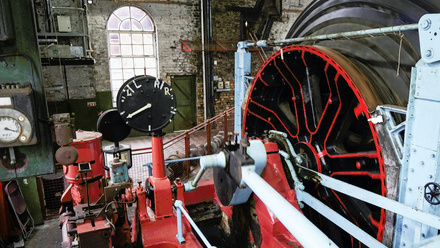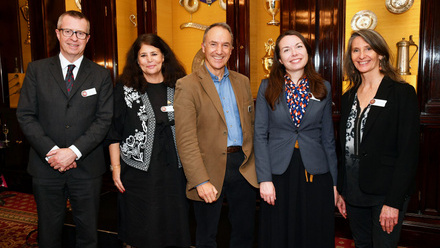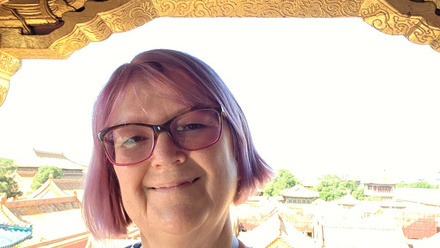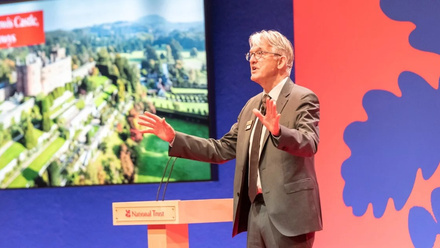I like to think of myself as a pragmatist who bases choices and decisions on empirical knowledge and evidence, with just the occasional flash of instinct. But, that said, I find myself enjoying the fact that I am writing this column on an auspicious date. The date is 6 December, fifteen years on from the first AGM of the Institute of Conservation. Many of the dedicated and determined individuals who worked extremely hard to create Icon from its parent bodies are, happily, still key members of the Icon family, so this is a fitting time to pay tribute to their vision for a new strategic conservation body which would champion cultural heritage and speak with a united voice in order to raise the profile of the incredibly important work of conservators and heritage scientists. Thanks to their good sense and strong leadership Icon was built on a firm foundation of sound governance practice and, despite the odd up and downs that every charity experiences, we find ourselves in fairly robust shape fifteen years later. Admittedly, there is still work to be done and, like most teenagers, we’re still testing the boundaries while we find our mature identify, but we are building on a strong set of values and a clear purpose that will stand us in good stead for the coming years.
If you’d like to learn more about the first AGM of the newly fledged Institute of Conservation we tell the story in this article. We also caught up with the members of Icon’s first Board of Trustees and asked them to tell us where they are now and to share their reflections – it’s a fascinating read.
Taking an opportunity to look back has been something of a theme recently. In October I was asked to participate in an event run by the central region of the RSA (the Royal Society for Arts, Manufactures and Commerce). The topic was sustainable heritage and in preparing my five-minute presentation on the theme of climate change I recalled the architectural history lectures I used to give on the origins of the conservation moment in the UK and the creation of the Society for the Protection of Ancient Buildings (SPAB). I began my talk by introducing John Ruskin, whose ideas inspired William Morris with a love of old buildings and fostered his determination to argue the case for conservation rather than restoration.
The idea of custodianship (Ruskin) or guardianship (Morris) still guides how we approach the care of our cultural heritage today. I believe that we all share their view that conservation of buildings, objects and collections is fundamental if we want to be able to pass on this heritage to future generations so that they can enjoy it and learn from it. We know that our cultural heritage is an irreplaceable resource, and our commitment to our shared responsibility to preserving it remains resolute, and has been a key driver of our strategic advocacy priority to articulate the value of conservation this year. As Anni’s work on the value of conservation project draws to a close we are launching an important booklet in addition to her research report. The booklet is in two parts; the first part is Collections Care: An Act of Custodianship, which is a reminder of the duty of care placed on all those who have a responsibility for collections.
Above all, museums are responsible for collections – not just for the present, but for future generations. Although this is an obvious point, it is one that imposes particular challenges. The Mendoza Review: An Independent Review of Museums in England
This new booklet makes the point that good custodianship is founded in three key actions: strategic planning for ongoing collections care; the implementation of monitoring processes; and a commitment to addressing problems before they escalate. It makes the case that time and effort spent on routine care and housekeeping, and on fixing issues as they arise is inevitably cheaper and more cost effective than having to put right much more extensive damage later. Investing in preventive conservation that focuses on long-term preservation and minimising deterioration is one of the most cost-effective ways that trustees can fulfil their duties as guardians of cultural heritage and is an important message that we want to promote.
Trustee ownership confers duties rather than rights. Trustees… hold the collection exclusively for the advantage of the beneficiaries. Neil MacGregor
The second part is Collections Care: An Act of Optimism, which looks to the future and sets out the value that conservation brings to society in terms of its contribution to increasing accessibility, widening participation in cultural activity, addressing climate change, and providing a resource to support people’s health and wellbeing. Collections Care: An Act of Optimism is therefore part of a growing body of policy that attempts to demonstrate that cultural heritage can be one of the tools in the toolbox that will help society to ‘build back better’ as we recover from the global Coronavirus pandemic. This is supported by recent action-centred research by the British Council and a report by the RSA which has championed the idea that, rather than hermetically sealing ‘heritage’ in a box in order to ensure its preservation for the future, we should use our heritage to connect and enable people to envision a better and more equitable future.
The principle that cultural heritage can be an effective driver of sustainable development is at the heart of the British Council’s Cultural Heritage for Inclusive Growth programme, which promotes a ‘people-centred’ approach to cultural heritage. However, as Stephen Stenning, Head of Arts and Society at the British Council, notes: “being people-centred’ doesn’t mean finding ways of educating more people to appreciate the things that administrations think they should venerate. It means being inclusive and respectful of those whose heritage we engage with – discovering aspects of a culture that people cherish, which gives value to their lives and that they wish to pass on to future generations.”
This would appear to me to be exactly what the conservation of objects, collections and the wider built environment enables. To learn from the past people need to be able to interact with artefacts and archives so that they can unlock the stories within the objects. This is only possible when the objects are in a safe and stable condition, and the collection as a whole is effectively and efficiently maintained and made accessible for enjoyment as well as research and education. So, thoughtful custodianship and investment in the care of our cultural heritage is money well spent that will pay dividends in the benefits to society in the coming years. We will continue to champion this message.






